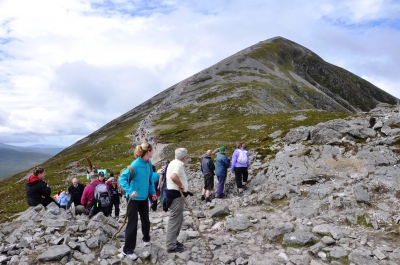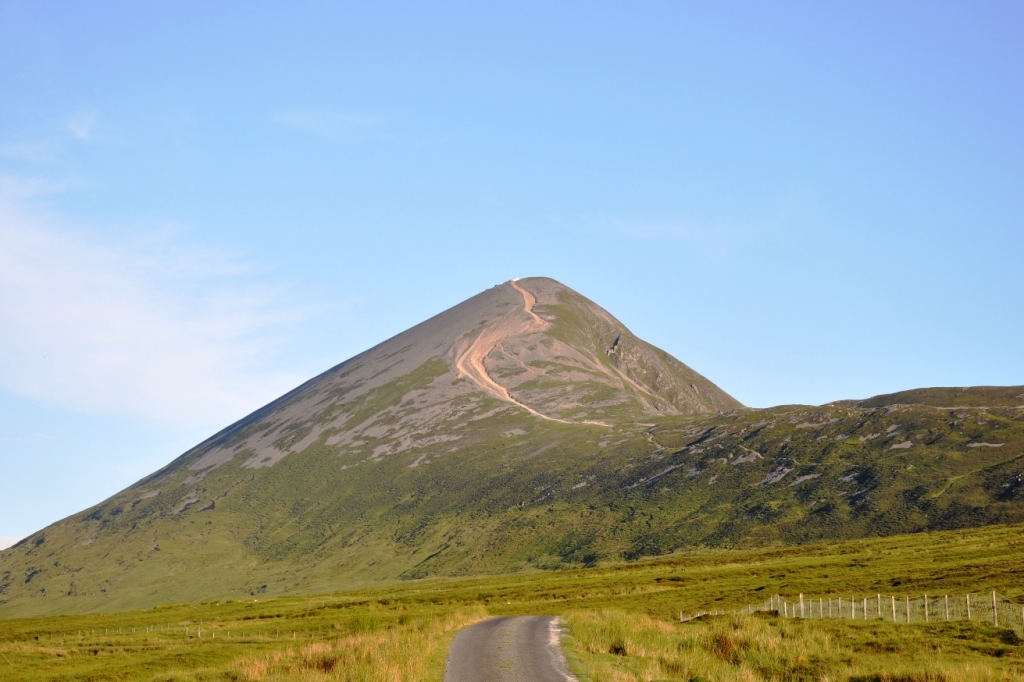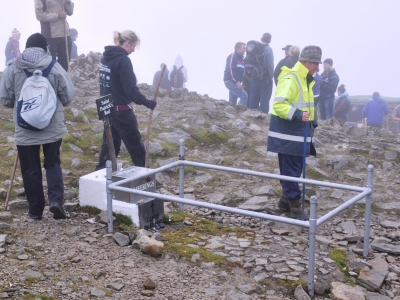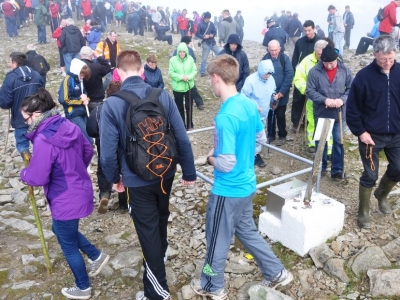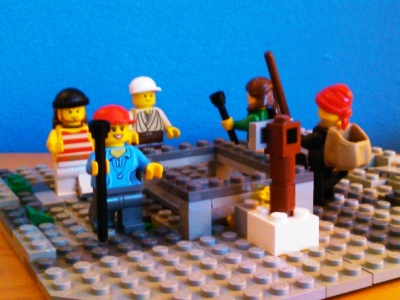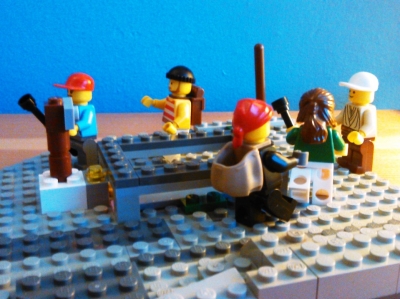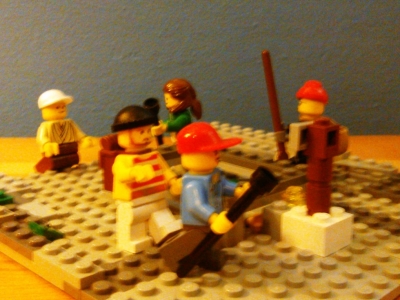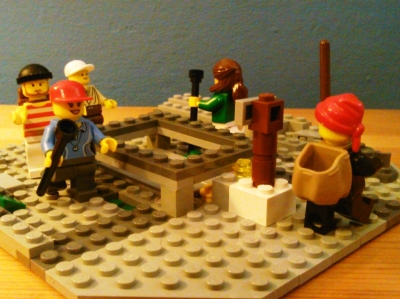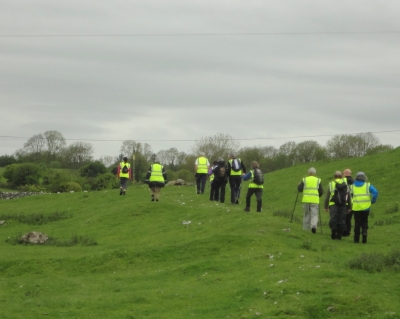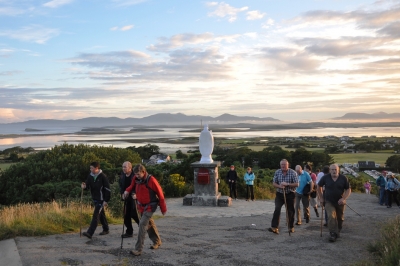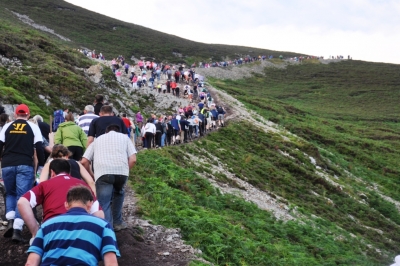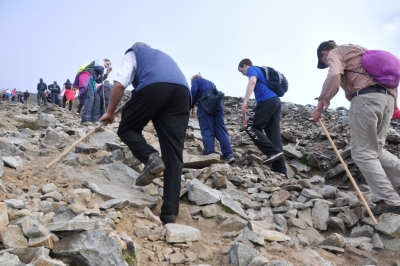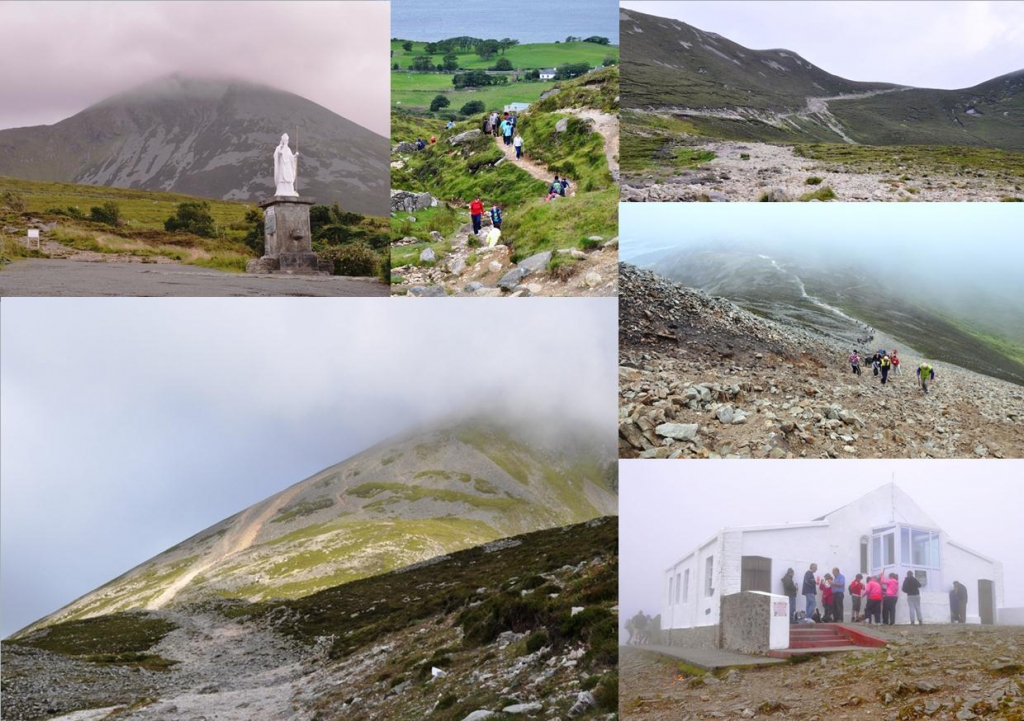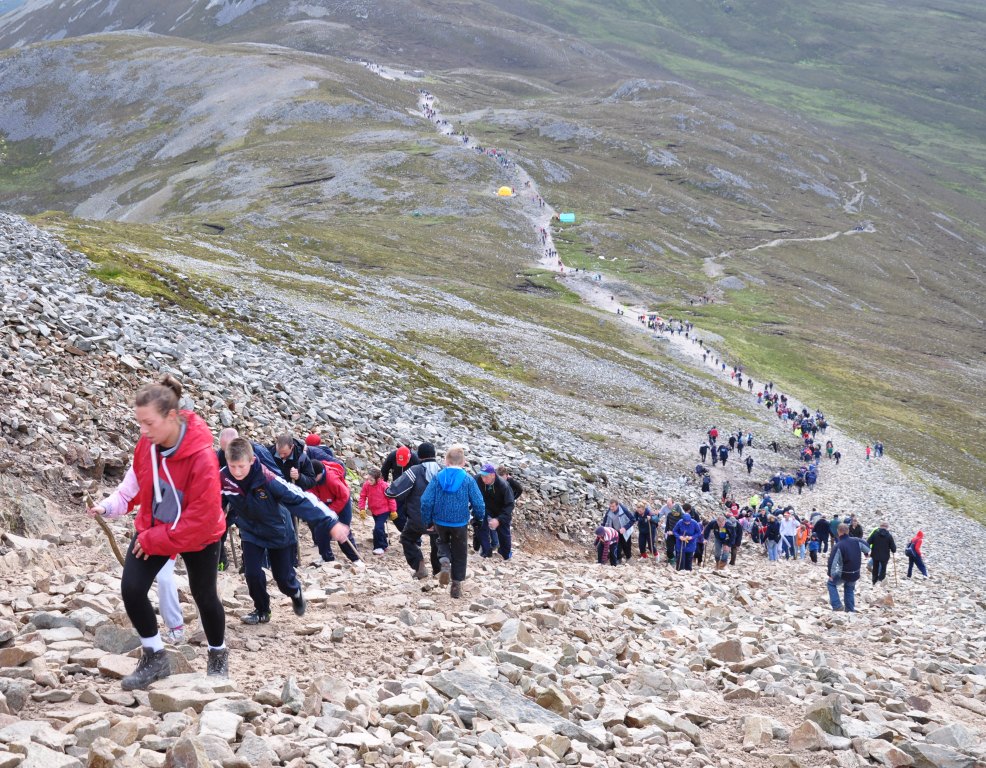Ireland’s Holy Mountain: symbiosis, co-existence and tensions on Croagh Patrick
My first paper at the RGS-IBG Annual Conference 2014 is within the session Sacred Space, Pilgrimage, and Tourism which looks at sacred space through the areas of the sacred, such as pilgrimage/theology/spirituality/belief systems, and the more secular, incuding tourism/leisure/promotion/visitor behaviour. My contribution is on Croagh Patrick.
Recreating Leaba Phádraig
‘St Patrick’s Bed’ (Leaba Phádraig) stands on top of Croagh Patrick as a focal point of ritual activity as pilgrims round the feature repeated sets of prayers. Small votive offerings and donations are also left there. In developing, my attempts to materialise or ‘Lego’ my research, I’ve tried to recreate a scene of pilgrims circling and praying at the bed.
Walking Tóchar Phádraig
“As you ‘walk the Tóchar’, whether on foot or in fantasy, you will be going not only on a spiritual pilgrimage, but on a cultural and historical journey down through the ages also. And both experiences, if fully entered into, should bring about that change of heart and insight of mind which is essential to a pilgrim’s progress.” (p.v) Fr Frank Fahey in Tóchar Phádraig: a Pilgrim’s Progress.
Tóchar Pádraig is a walkway that leads from Ballintubber Abbey to Croagh Patrick. This old pilgrim road stretches c.35 km across mid-Mayo on a route that is both cross-country and on quite rural roads. Annually, Ballintubber Abbey organises four group walks during the summer months. This account is taken from one such event.
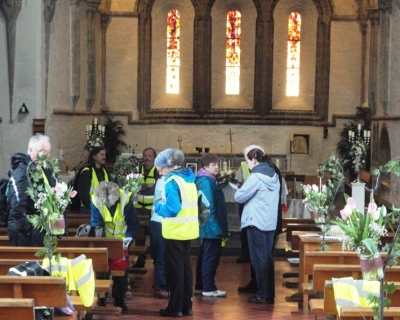
Pilgrims gathering in the morning in Ballintubber Abbey. Mixing and preparing for the pilgrimage ahead.
The gathering in the Abbey is a starting point where Fr Frank Fahey gives an introduction to the route and the concept of pilgrimage. Although some people arrive in the groups – in my case, my father accompanied me – most people don’t know each other. During the day people, through chat and travelling together, will get to know each other better, leading to the emergence of a camaraderie or communitas. My research was a nice topic of conversation which I shared with different people throughout the day.
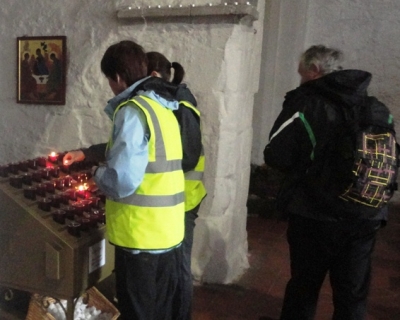
Pilgrims are invited to light candles before they begin walking. It serves as a means of connect with an intention and the Divine.
A tóchar is an historical route way which served an important land-based transport systems in ancient and medieval times. They were particularly associated with pilgrimages and ecclesiastical foundations. It is speculated that Tóchar Phádraig is based on an earlier route from Cruachain, Roscommon, the seat of the Kings of Connacht to Croagh Patrick, which itself is a site of ancient ritual activity.
The route meanders through the landscape, as we move in meadows, walk along ridges and navigate boggy areas. The removal from the everyday is most definitely expressed in the cross-country sections where soft paths carry us away from the world through quiet patches of nature. Even the on-road sections can be very sedate with little traffic coming by. This withdrawing from the rest of the world and our own lives is a central part of pilgrimage. The landscape itself, is central to the creation of this liminality.
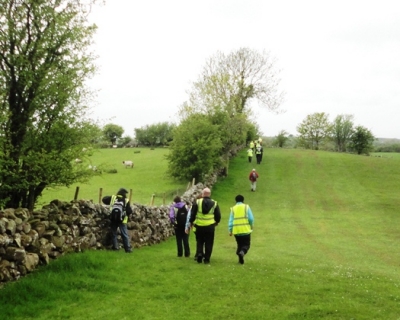
Walking through one of the many fields the Tóchar passes through, the group spreading out as people chat and walk.
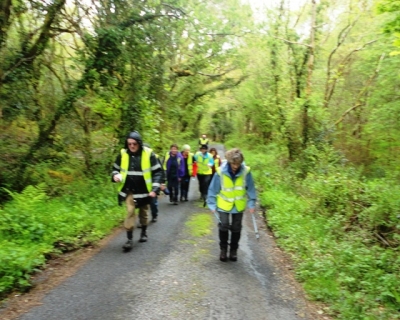
The Tóchar follows is known route as much as possible which involves walking on road and through countryside. However, many of the roads are very quiet boreens on which you encounter little, if any, traffic.
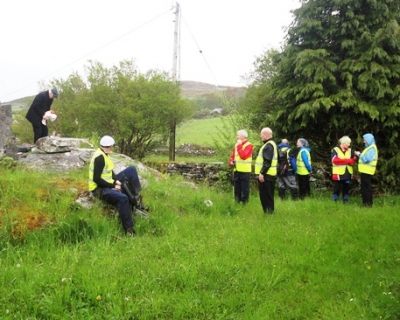
Gathering for mass on Boheh stone (St Patrick’s Chair) a former mass rock with ‘cup and ring’ motifs which are a fine example of neolithic rock art.

On the long stretches of road in Teevenacroaghy the group is very spread out. It is in the latter part of the day, as we approach Croagh Patrick.
Only a few climb to the actual summit of Croagh Patrick, as it is an extra undertaking: it is explained to us that the main part of the pilgrimage is the route itself, in doing this you have completed the pilgrimage. This speaks to an ideal of pilgrimage as a journey, rather than a destination. The typical outlook would see the summit of the Reek as a requirement, but in this event our attention is called to other ways of walking and being. It is a readjustment, a pleasant one.
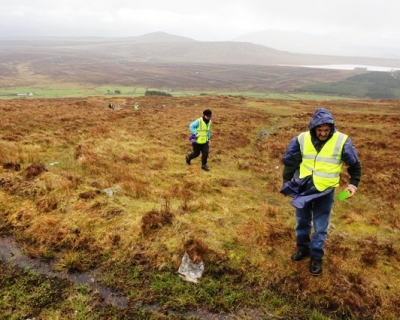
Beginning the climb of the Croagh Patrick ridge form the northern, Teevenacroaghy, side. The path is less clear here, as we walk across rough ground.
As the bus takes our group from Murrisk back to Ballintubber, we chat and rest. We say our goodbyes and each of us, in our previous groupings or as individuals, go on our own paths.
“Reminding yourself that life is a journey not a destination, you now let slow motion time drift past on diaphanous wings while you absorb the timeless sensations and colours of the Mayo countryside.” John O’Dwyer, Pilgrim Trail, The Irish Times, Jul 14, 2012.
Reading:
Tóchar Phádraig: a Pilgrim’s Progress. 1989, Ballintubber Abbey Publication, Mayo.
Reek Sunday 2013
Reek Sunday, the last Sunday in July, sees several thousand people climb Croagh Patrick on the southern shore of Clew Bay in Mayo. The sheer scale of the event and its links with the ancient and more modern past, mark it out as one of the most distinct events in Ireland. It is a combination of a variety of elements, including the Celtic feast of Lughnasa, Patrician lore, spiritual devotion, personal and familial tradition and the sense of an event. For a historical overview of Croagh Patrick, checkout the post from Pilgrimage in Medieval Ireland.
Although Croagh Patrick is climbed throughout the year, Reek Sunday is a special day. People from all over Ireland travel especially on that day. You are guaranteed to encounter all manner of humanity here. It is also on this day that some of the more religious or spiritual elements come to the fore. My fieldwork involved me engaging with the events, people and landscape of Croagh Patrick throughout Reek Sunday. I started off about 6am walking; however, I made frequent stops to photograph and record events. I spent a few hours on the summit taking everything in and talking to some people and, then, descended slowly, arriving down by 4pm.
This video is an amalgamation of different recordings I made throughout the day. It attempts to give a sense of the movements, sounds and moments that make up the pilgrimage.
One of the most striking aspects of the day is the significant numbers who are climbing at an early hour. While some people still practice the traditional night pilgrimage, the main crowds start arriving from about dawn. When I was walking up after 6am, there were at least several thousand people on the Reek. While most of the world rests on this Sunday morning, the approaching roads, fields being used as car parks and the paths are alive with activity. In a previous post, I have outlined the route and character of the main path leading up from Murrisk.
The steep pathway leading up the Reek proper – Casán Phádraig – is what is associated most frequently with Croagh Patrick. Pilgrims, usually with sticks, struggle up the loose surface, while those descending are moving cautiously, ever conscious of balance. On this day, the path is a stream of activity with hundreds of feet, unsecured stones, encounters and conversations. This audio secording gives as sense of how much is actually going on and how active the path is
The summit is the site of masses all morning with pilgrims gathering on the gable end of the Chapel from where the mass is celebrated; confessions are also available. While acting as a central point of the pilgrimage as a Catholic event, it is also related to the Plenary Indulgence associated with Croagh Patrick. Rounds of the chapel and St Patrick’s bed are practised, with each been circled by pilgrims saying the Rosary. Many others rest, eat and often take photos of the views across Clew Bay. Also, there are usually a number of stalls selling drinks, tea and bars of chocolate (at airport prices!). There is a sense of being separate from the mundane on the mountain. The views allows a wider perspective, with many of the immediate concerns being left behind. This sense is a crucial component of the pilgrimage experience; and, although the summit is so busy there is still a feeling of being removed from everything else
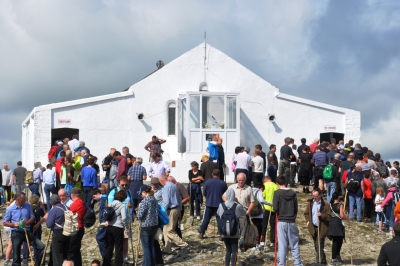
St Patrick’s Chapel on the summit, just after one of the masses (one every half hour between 8am & 2pm). Pilgrims on the left are queueing for Confessions and those on the right for Communion.
A recording of the gospel (The Beatitudes formthe Sermon on the Mount, Matthew 5:3–12) at the 9.30am mass, read by Archbishop Charles John Brown, Apostolic Nuncio to Ireland.
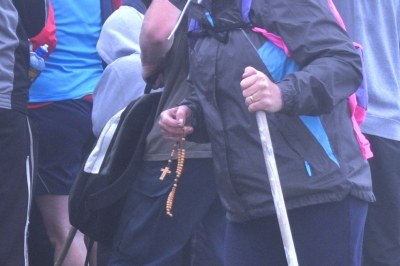
A pilgrim rounding the chapel with their rosary beads. The congregation at mass are in the background.
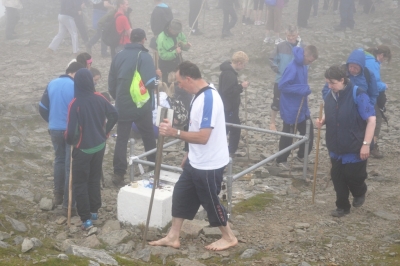
Leaba Phádraig: A number of pilgrims follow the traditional stations of the route by rounding St Patrick’s Bed reciting prayers.
Going down, which is often seen as being more challenging, involves steady footing and heavy use of the stick almost as a third foot. The mountain is known for the camaraderie it encourages in people. Those descending continually assure those coming up that there almost there, some giving slightly unrealistic estimations, possible to bolster confidence and determination. Furthermore, these seems to have been a perennial characteristic of Croagh Patrick with one 1910 commentator, known only as E O’L. writing in The Irish Monthly saying that such assurances were “well calculated to cheer and revive the drooping spirits, such as ” Bravo ! you’re getting on grand, you have only a few hundred yards more to climb,”…” (p.592).
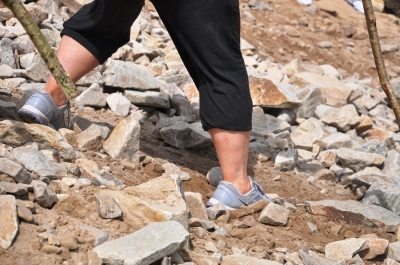
Descending the Casán: going down the steep path on uncertain surfaces is often considered to be the most challening aspect. Here the feet, the means by which the pilgrim engages physically with the mountain, are adjusting to the incline.
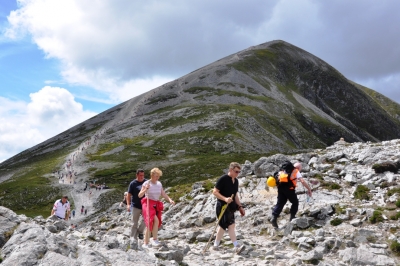
The Reek proper in the early afternoon, the steady flow of pilgrims are evident, animating the path all the way up the peak.
Further down the path one goes the more the everyday world encroaches, as everything gradually becomes closer and more real. Adding to this sensation is the collection of stalls and people at the end of the path. Whether selling or promoting something, they speak to a real world, with concerns beyond the mountain
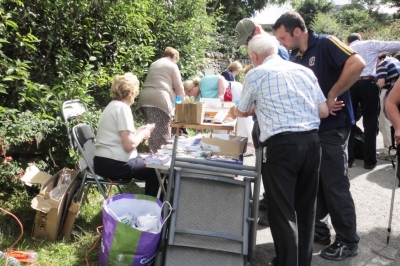
Numerous groups and business set up stalls at the base of the path in Murrisk. While, some are promotion particular causes or denominations, others are selling religious items or food.
This was my second Reek Sunday (both being motivated by my research), but I’ve already grown fond of the day. It has a distinct feel to it and I can understand some of what draws people back year after year. Also, the role played by groups such as volunteer first aiders, stewards, Gardaí, the Air Corps, clergy and local people should be acknowledged.
Suggested Reading:
Hughes, H., 2005. Croagh Patrick: Ireland’s Holy Mountain. The Croagh Patrick Archaeological Committee.
Hughes, H., 2010. Croagh Patrick: a place of pilgrimage, a place of beauty. O’Brien Pub.
O’L., E., 1910. A Pilgrimage to Croagh Patrick: July 31, 1910. The Irish Monthly, 38(448), pp.585–596.
Road to Emmaus staff, 2011. Croagh Patrick: The glorious climb of Ireland’s holy mountain. Road to Emmaus, 12(2), pp.1–45.
Croagh Patrick May 2012
During May I participated in two pilgrimages on Croagh Patrick with different two groups. The first was with Pilgrimage Project, a collaborative project which was run in May 2013 and connected a group of Irish, Icelandic and Greek musicians, visual and performative artists. The second was with Tuam Diocesan Youth Council which aims to provide opportunities for young people to develop and nurture their faith.
Both were very enjoyable days and presented different ways of considering and experiencing the Reek. The first offered more historic outlook which was attentive to the ancient origins and the role of mountains as locations of interaction with deities and the otherworldly. This pilgrimage centred on the ideals of a group of people coexisting, living and working together in exploration of cultural identity. The conversation, on the journey and in eating on the summit, touched on the landscape and links between island or peripheral places.
The second climb of Croagh Patrick was a religious pilgrimage. It was part of an annual calendar of events run by the Catholic Archdiocese of Tuam’s Youth Council. The event was designed to help young people explore and develop their faith. A strong wind made for a tough climb, while mass in the oratory was a pleasant communal experience.
In both cases, I was lucky enough to participate in a larger group. This enabled me to walk along with others, share stories and get a chance to consider different forms of pilgrimage, which unfolded on the one site.
As previously discussed, I use video as a method in my research. It serves both as a research tool and as a means of presenting my work. I have complied two short videos based on the two pilgrimages. The Pilgrimage Project video gives a sense of the journey of a group by locating it temporally, as well as giving the briefest interpretation to events. The Youth Pilgrimage video was formatted to capture a sense of the purpose of the event. It layers audio recordings from the mass onto the journey, linking the performance and meaning.
Making Places Holy
What makes a place holy? What are the features, criteria or origins surrounding a space that we use to decided on its sacredness? How does the origins of a place relate to its contemporary form? These are some of the questions that define the explorations of holy places.
The first point to consider is that the idea of a sacred place is based on the concept that the holy or spiritual can become emplaced or embodied in a particular location. The spiritual, ethereal or otherworldly spheres are manifest or at least more easily accessed in these spaces, which therefore mark them out from the rest of the world. Although, I’ve previously written on the idea that this demarcation of sacred and secular spaces is not as strict as previously thought, there are still numerous locations across the world that are considered different and special.
In many cases, the origin of a holy place lies in some event or intervation. A significant episode in the history of a religion occurred there (Jerusalem in the Abrahamic religions), a divine figure was known to have been there, a saintly individual lived there or an apparition or miracle happened there. Through such elements a place is given its sacred credentials.
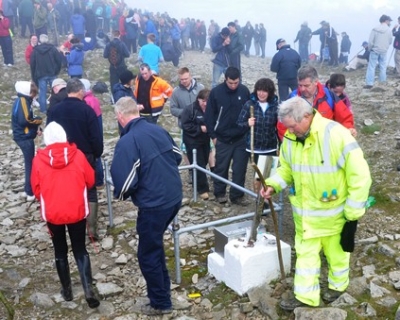
St Patrick’s Bed, Croagh Patrick, July 2012: Although the origin of Croagh Patrick as a holy mountain is because of the stories that St Patrick spent Lent on the Reek, its contemporary role lies in the continuation of worship and practices over the centuries.
However, it is the practices at these sites and the venerations there that sustain these locations as holy places. While the genesis of such sites may be attributed to the divine or sacred realm it is human activities that ensure their continuation. In visiting holy places, in treating them as a distinct special spaces and by engaging in specific rituals at these sites, people are making and re-making these places as scared spaces. Individuals, communities and religious organisations, therefore, have a central role in the creation and maintenance of holy spaces.
This interpretation centres on a core idea of human geography, that people and places define each other. While there maybe be some otherwordly origins to these sites, it is the actions, ideas and believes of humans, sometimes over many centuries, that ensure the continued presence of these spaces in the landscape.
Suggested Readings:
Belhassen, Y., Caton, K. and Stewart, W.P. 2008. The Search for Authenticity in the Pilgrim Experience. Annals of Tourism Research, 35 (3), pp. 668–689.
Hughes, J. D. and Swan, J. 1986. How Much of the Earth Is Sacred Space? Environmental Review: ER, 10 (4), pp. 247-259.
Kong, L., 2001, ‘Mapping ‘new’ geographies of religion: politics and poetics in modernity’, Progress in Human Geography, 25 (2), 211–233.
The Path: Croagh Patrick
This collection of images represents the main path on Croagh Patrick. Most people who climb the mountain do so along this route, which runs from Murrisk, with a car park and amenities, up the to main ridge, along a section of that ridge and then up the Reek proper. This path is what defines the Croagh Patrick experience for most people. Its uneven surface, its weaving up the ridge and its loose screen shape the climb. The devoted pilgrim, the curious tourist and eager hillwalker all engage with the same trail, each experiencing it in their own way.
Photos, clockwise from top left-hand corner: the statue of St Patrick at the base of the mountain; walkers moving through a narrow gap in a small ridge shortly into the climb; the path weaving up the northern slope of the main ridge; looking down on Casán Phádraig (the path of St Patrick) with its steep incline and loose scree; a group of pilgrims eating and chatting in the shelter of the chapel on the summit; Casán Phádraig climbs up the scree on the side of the Reek.
Reek Sunday 2012: Pilgrims climb Croagh Patrick
A photo showing people climbing Croagh Patrick on the annual pilgrimage day, Reek Sunday (the last Sunday in July). The photo looks eastward, down the path from a little way up the scree-covered peak and across the ridge, which the main path runs across. This section of path is known as Casán Phádraig, the path of St Patrick. The significant number of ‘pilgrims’ results in lines or flows of people, almost creating one continuous row going up the mountain. The large crowd animates the path itself. The erosion of the path, the relative smooth surface of the most walked-on section and the loose nature of the outer track are all evident. The mountain rescue/first aid tents are visible below in the middle ground.
